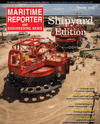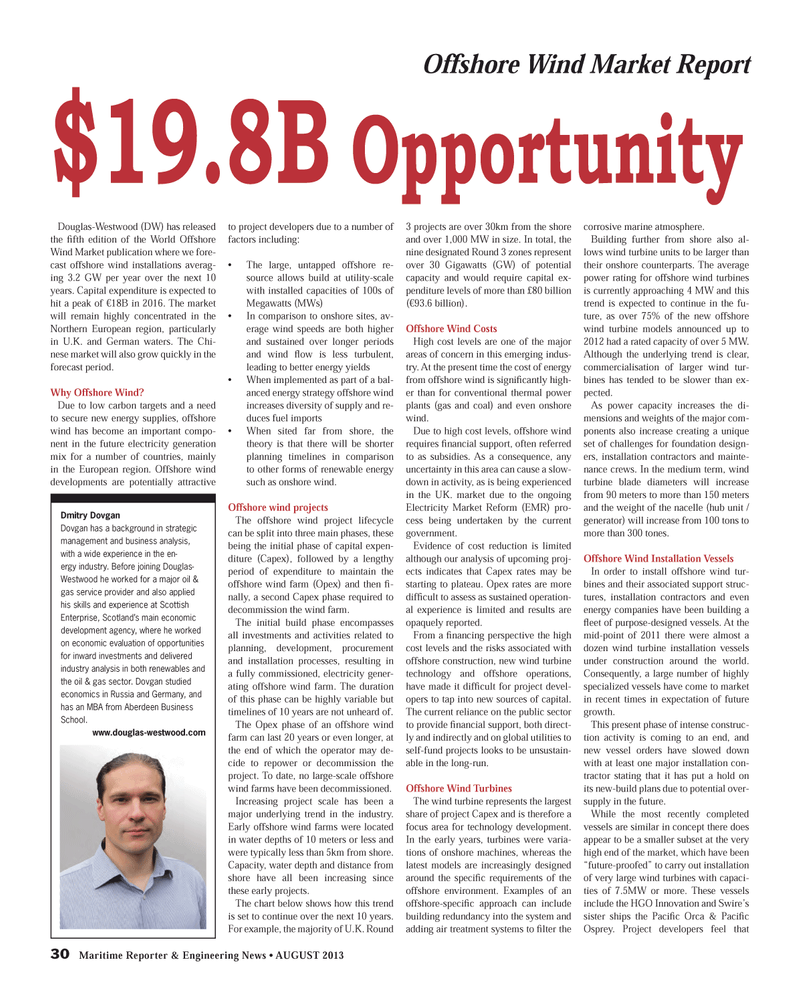
Page 30: of Maritime Reporter Magazine (August 2013)
Shipyard Edition
Read this page in Pdf, Flash or Html5 edition of August 2013 Maritime Reporter Magazine
30 Maritime Reporter & Engineering News ? AUGUST 2013 Douglas-Westwood (DW) has released the Þ fth edition of the World Offshore Wind Market publication where we fore- cast offshore wind installations averag- ing 3.2 GW per year over the next 10 years. Capital expenditure is expected to hit a peak of ?18B in 2016. The market will remain highly concentrated in the Northern European region, particularly in U.K. and German waters. The Chi- nese market will also grow quickly in the forecast period.Why Offshore Wind? Due to low carbon targets and a need to secure new energy supplies, offshore wind has become an important compo-nent in the future electricity generation mix for a number of countries, mainly in the European region. Offshore wind developments are potentially attractive to project developers due to a number of factors including:? The large, untapped offshore re- source allows build at utility-scale with installed capacities of 100s of Megawatts (MWs)? In comparison to onshore sites, av- erage wind speeds are both higher and sustained over longer periods and wind ß ow is less turbulent, leading to better energy yields ? When implemented as part of a bal- anced energy strategy offshore wind increases diversity of supply and re-duces fuel imports? When sited far from shore, the theory is that there will be shorter planning timelines in comparison to other forms of renewable energy such as onshore wind.Offshore wind projects The offshore wind project lifecycle can be split into three main phases, these being the initial phase of capital expen-diture (Capex), followed by a lengthy period of expenditure to maintain the offshore wind farm (Opex) and then Þ -nally, a second Capex phase required to decommission the wind farm. The initial build phase encompasses all investments and activities related to planning, development, procurement and installation processes, resulting in a fully commissioned, electricity gener- ating offshore wind farm. The duration of this phase can be highly variable but timelines of 10 years are not unheard of.The Opex phase of an offshore wind farm can last 20 years or even longer, at the end of which the operator may de-cide to repower or decommission the project. To date, no large-scale offshore wind farms have been decommissioned. Increasing project scale has been a major underlying trend in the industry. Early offshore wind farms were located in water depths of 10 meters or less and were typically less than 5km from shore. Capacity, water depth and distance from shore have all been increasing since these early projects.The chart below shows how this trend is set to continue over the next 10 years. For example, the majority of U.K. Round 3 projects are over 30km from the shore and over 1,000 MW in size. In total, the nine designated Round 3 zones represent over 30 Gigawatts (GW) of potential capacity and would require capital ex-penditure levels of more than £80 billion (?93.6 billion).Offshore Wind Costs High cost levels are one of the major areas of concern in this emerging indus-try. At the present time the cost of energy from offshore wind is signi Þ cantly high- er than for conventional thermal power plants (gas and coal) and even onshore wind. Due to high cost levels, offshore wind requires Þ nancial support, often referred to as subsidies. As a consequence, any uncertainty in this area can cause a slow-down in activity, as is being experienced in the UK. market due to the ongoing Electricity Market Reform (EMR) pro-cess being undertaken by the current government.Evidence of cost reduction is limited although our analysis of upcoming proj-ects indicates that Capex rates may be starting to plateau. Opex rates are more difÞ cult to assess as sustained operation- al experience is limited and results are opaquely reported. From a Þ nancing perspective the high cost levels and the risks associated with offshore construction, new wind turbine technology and offshore operations, have made it difÞ cult for project devel- opers to tap into new sources of capital. The current reliance on the public sector to provide Þ nancial support, both direct- ly and indirectly and on global utilities to self-fund projects looks to be unsustain-able in the long-run.Offshore Wind Turbines The wind turbine represents the largest share of project Capex and is therefore a focus area for technology development. In the early years, turbines were varia-tions of onshore machines, whereas the latest models are increasingly designed around the speciÞ c requirements of the offshore environment. Examples of an offshore-speci Þ c approach can include building redundancy into the system and adding air treatment systems to Þ lter the corrosive marine atmosphere. Building further from shore also al-lows wind turbine units to be larger than their onshore counterparts. The average power rating for offshore wind turbines is currently approaching 4 MW and this trend is expected to continue in the fu-ture, as over 75% of the new offshore wind turbine models announced up to 2012 had a rated capacity of over 5 MW. Although the underlying trend is clear, commercialisation of larger wind tur- bines has tended to be slower than ex-pected.As power capacity increases the di-mensions and weights of the major com-ponents also increase creating a unique set of challenges for foundation design-ers, installation contractors and mainte-nance crews. In the medium term, wind turbine blade diameters will increase from 90 meters to more than 150 meters and the weight of the nacelle (hub unit / generator) will increase from 100 tons to more than 300 tones.Offshore Wind Installation Vessels In order to install offshore wind tur- bines and their associated support struc-tures, installation contractors and even energy companies have been building a ß eet of purpose-designed vessels. At the mid-point of 2011 there were almost a dozen wind turbine installation vessels under construction around the world. Consequently, a large number of highly specialized vessels have come to market in recent times in expectation of future growth.This present phase of intense construc-tion activity is coming to an end, and new vessel orders have slowed down with at least one major installation con-tractor stating that it has put a hold on its new-build plans due to potential over- supply in the future.While the most recently completed vessels are similar in concept there does appear to be a smaller subset at the very high end of the market, which have been ?future-proofed? to carry out installation of very large wind turbines with capaci- ties of 7.5MW or more. These vessels include the HGO Innovation and Swire?s sister ships the PaciÞ c Orca & Paci Þ c Osprey. Project developers feel that $19.8B OpportunityOffshore Wind Market Report Dmitry DovganDovgan has a background in strategic management and business analysis, with a wide experience in the en-ergy industry. Before joining Douglas- Westwood he worked for a major oil & gas service provider and also applied his skills and experience at Scottish Enterprise, Scotland?s main economic development agency, where he worked on economic evaluation of opportunities for inward investments and delivered industry analysis in both renewables and the oil & gas sector. Dovgan studied economics in Russia and Germany, and has an MBA from Aberdeen Business School.www.douglas-westwood.com MR #8 (26-33).indd 30MR #8 (26-33).indd 308/1/2013 9:28:29 AM8/1/2013 9:28:29 AM

 29
29

 31
31
